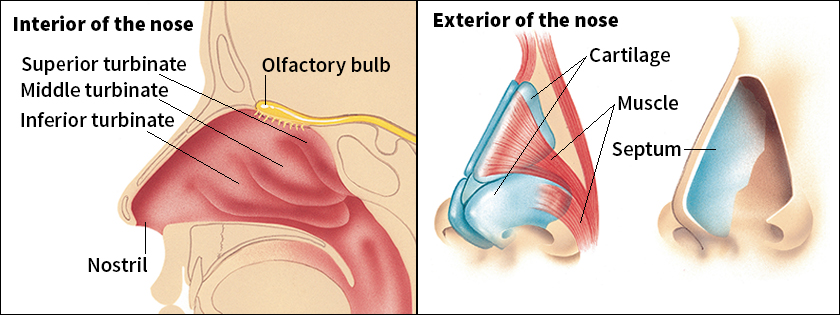Nose is the organ used for breathing and smelling. It forms part of the face, just above the mouth. Outwardly, it seems simple, but it is complicated inside.

When we breathe, air enters the nose through two openings called nostrils. The nostrils are separated by the septum, a thin wall of cartilage (tough tissue) and bones. Air passes from the nostrils into two tunnels called the nasal passages, which lead back to the upper part of the throat. From the nasal passages, air passes through the pharynx and trachea into the lungs.
Both nasal passages have a lining of soft, moist mucous membrane covered with microscopic, hairlike projections called cilia. The cilia move in coordination, passing dust, bacteria, and fluids from the nose to the throat for swallowing. Each nasal passage also has three large, shelflike bones that are called conchae or turbinates. The top two conchae on each side are actually processes (extensions) of the ethmoid bone. The lowest concha on each side is a separate bone. The conchae warm the air before it enters the lungs. These bones also stir up the air so that dust in the air sticks to the mucous membrane of the conchae and does not pass into the lungs.
The perception of smell occurs in the highest part of the nasal cavity, where olfactory nerve receptors lie in a small, flat piece of mucous membrane about the size of a thumbnail. These receptors generate nerve impulses in response to chemicals in the air. Olfactory nerve fibers then carry the impulses to a part of the brain called the olfactory bulb. One olfactory bulb lies just above each nasal passage. From there, the impulses are carried to other parts of the brain, where they are translated into sensations of odor.

The sense of smell is closely related to the sense of taste. Some experts believe that much of our taste sensations are really sensations of odor that we have associated with certain tastes. For example, we really smell coffee, tobacco, wine, apples, and potatoes more than we taste them. If a person is blindfolded and the nose stopped up so that the person cannot smell, the person has great difficulty telling apples from potatoes by taste. Red wine and plain coffee taste almost alike to such a person when they are at the same temperature and consistency.
We cannot smell when we have a cold, because the infection inflames the mucous membrane of the nasal passages and blocks the passage of air to the center of smell. It is important to keep nasal passages clean and to treat any inflammation of the mucous membrane right away. When neglected, colds can lead to more serious ailments, such as bronchitis and pneumonia. Sinuses, which empty into the nose, may also become infected.
